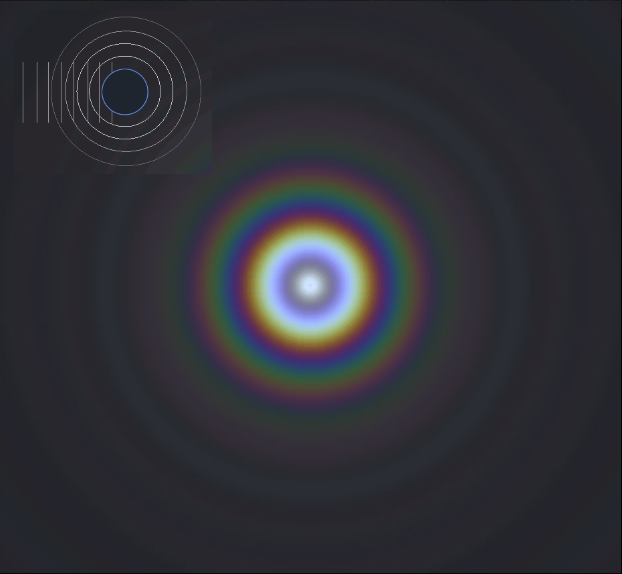OPOD - Maxwell's glory
OPOD - Maxwell's Glory: Understanding the Phenomenon
Maxwell's glory is a captivating atmospheric optical phenomenon that surrounds the shadow of an object, such as a telescope, on a cloud or mist. This beautiful phenomenon is formed by the interaction of light with water droplets in the atmosphere. In this article, we will delve deeper into the intricacies of Maxwell's glory, exploring its formation, underlying physics, and recent advancements in understanding this phenomenon.
The Origin of Maxwell's Glory
Maxwell's glory owes its name to James Clerk Maxwell, a Scottish physicist and mathematician who published four equations in the early 1860s that elegantly described classical electricity and magnetism. These equations, when applied to periodic electric and magnetic fields, also explain the behavior of light. When sunlight, for example, interacts with a homogeneous sphere like a water droplet, Maxwell's equations produce further equations that accurately describe the resulting light scattering. This phenomenon is known as Mie scattering, named after Gustav Mie and Ludvig Lorenz, who made significant contributions to its understanding in the early 1900s.
The Beauty of Mathematical Physics
Mie scattering theory, derived from Maxwell's equations, accounts for various optical processes and interactions involved in light scattering. It considers diffraction around the droplet, reflections from its surface, transmission through it, internal reflections, and more. These solutions automatically generate a corona, fogbow or rainbow, and Maxwell's glory opposite the sun. It is a triumph of mathematical physics that accurately predicts these optical phenomena without requiring additional physical insights beyond the initial formulation.
The Elusive Nature of Insight
Despite the exactitude and elegance of Mie scattering theory, understanding the underlying mechanisms of Maxwell's glory remains a challenge. While simpler mental models help us comprehend phenomena like the corona and rainbow, there is a lack of simple models for the glory. Consequently, we are left with an exact theory but a dearth of insight into the intricacies of this fascinating phenomenon.
Recent Advances in Understanding Maxwell's Glory
Although gaining a complete understanding of Maxwell's glory continues to elude us, recent research has shed some light on the subject. Philip Laven's work, for instance, explores alternative formulations of scattering theory and provides valuable insights into the formation of glories. By leveraging these alternative approaches, we can begin to unravel the mysteries of how light forms a glory.
Overcoming Computational Challenges
For many years, numerical predictions based on the exact Mie-Lorenz scattering theory were rarely attempted due to the laborious and time-consuming arithmetic involved. However, advancements in computational power have revolutionized the field. Today, solutions that previously took hours or even days to compute can be generated within seconds. This newfound efficiency allows researchers to explore and simulate various scenarios, enhancing our understanding of atmospheric optics phenomena like Maxwell's glory.
Conclusion
Maxwell's glory is a captivating atmospheric optical phenomenon that surrounds the shadow of an object, forming a multi-ringed glory opposite the sun. While its exact formation remains elusive, the mathematical elegance of Mie scattering theory provides accurate predictions of this phenomenon. Recent research and advancements in computational power have enabled scientists to gain further insights into the mechanisms underlying Maxwell's glory. By continuing to explore alternative formulations and simulations, we inch closer to unraveling the secrets of this mesmerizing atmospheric spectacle.

Glory & Telescopes
Brigitta Sipocz imaged this glory on Christmas Day 2010 on La Palma, Spain. The island has exceptionally good atmospheric conditions and is the home of several major telescopes. The multi-ringed glory surrounds the shadow of the INT (Isaac Newton Telescope). The JKT (Jacobus Kapteyn Telescope) is to the right and Mercator to the left. ©Brigitta Sipocz, shown with permission.

In the early 1860s the Scottish physicist and mathematician James Clerk Maxwell published four equations that most succinctly, beautifully and exactly express classical electricity and magnetism. When written for periodic electric and magnetic fields, the equations describe the behaviour of light.
When Maxwell�s equations are applied to the instance of a plane wave (for example sunlight) interacting with a homogeneous sphere (a water droplet) they produce further equations that describe - without any approximation - the resulting light scattering. All this was achieved in the early 1900s by several workers but mainly Gustav Mie and Ludvig Lorenz. The theory is generally known as Mie scattering.
The theory automatically takes account of all the optical processes and interactions, e.g. diffraction around the drop, reflections from the drop surface, transmission through the drop, internal reflections and so on. No extra physical insight is needed beyond the initial formulation.
Solutions automatically produce a corona, a fogbow or rainbow and a glory opposite the sun. They are a triumph of mathematical physics.
Ironically, all this exactitude and elegance gives few clues to what is actually happening! We have alternative - but approximate - mental models that help us to comprehend the corona and rainbow. Simple models for the glory are, however, lacking and we are left with an exact theory but wont of insight.
Nonetheless, some understanding can be derived from alternative formulations of the scattering theory and Philip Laven�s recent work helps us see what is happening when light forms a glory.
For decades, numerical predictions from the exact Mie-Lorenz scattering theory were rarely attempted because the arithmetic was so laborious and time consuming. Now, the solutions are produced in seconds as in the IRIS simulation at right.
Note: this article has been automatically converted from the old site and may not appear as intended. You can find the original article here.
Reference Atmospheric Optics
If you use any of the definitions, information, or data presented on Atmospheric Optics, please copy the link or reference below to properly credit us as the reference source. Thank you!
-
<a href="https://atoptics.co.uk/blog/opod-maxwells-glory/">OPOD - Maxwell's glory</a>
-
"OPOD - Maxwell's glory". Atmospheric Optics. Accessed on November 26, 2024. https://atoptics.co.uk/blog/opod-maxwells-glory/.
-
"OPOD - Maxwell's glory". Atmospheric Optics, https://atoptics.co.uk/blog/opod-maxwells-glory/. Accessed 26 November, 2024
-
OPOD - Maxwell's glory. Atmospheric Optics. Retrieved from https://atoptics.co.uk/blog/opod-maxwells-glory/.